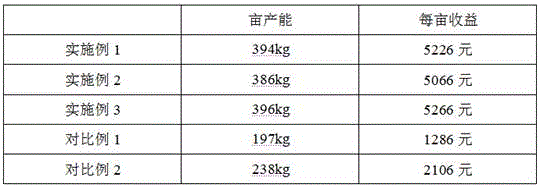Method for interplanting angelica sinensis under ginkgo forest
An under-forest intercropping and ginkgo technology, which is applied in the agricultural field, can solve problems such as waste of ginkgo forests, and achieve the effects of preventing soil erosion, creating economic benefits, and strong and thick roots.
- Summary
- Abstract
- Description
- Claims
- Application Information
AI Technical Summary
Problems solved by technology
Method used
Image
Examples
Embodiment 1
[0026] (1) Site selection and preparation: In early July, select shady, humus-rich loam, loose soil, and fertile sandy loam in the ginkgo forest; remove weeds, plow the land more than 25 cm deep, and weather it in the sun. Before planting, apply 2000kg of decomposed medicinal residues per mu in combination with site preparation (composed of the following components by mass: 120 parts of asarum medicinal residues, 350 parts of Astragalus medicinal residues, 320 parts of licorice residues, 75 parts of rice bran, and 15 parts of urea), calcium Magnesium phosphate fertilizer or calcium superphosphate 30kg, commercially available potassium dihydrogen phosphate fertilizer 20kg, poured into the soil as base fertilizer; shallow plowing once before sowing, make a 1-meter-wide high furrow between two rows of ginkgo trees, furrow width 30 cm, Sprinkle phoxim granules on the furrow surface as usual, and open drainage ditches around;
[0027] (2) Seed treatment: select seeds with purity ≥ ...
Embodiment 2
[0036](1) Site selection and preparation: In early July, select shady, humus-rich loam, loose soil, and fertile sandy loam in the ginkgo forest; remove weeds, plow the land more than 25 cm deep, and weather it in the sun. Before planting, apply 2000kg of decomposed medicinal residues per mu in combination with site preparation (composed of the following components by mass: 100 parts of Asarum medicinal residues, 300 parts of Astragalus medicinal residues, 300 parts of licorice residues, 70 parts of rice bran, and 10 parts of urea), calcium Magnesium phosphate fertilizer or calcium superphosphate 30kg, commercially available potassium dihydrogen phosphate fertilizer 20kg, poured into the soil as base fertilizer; shallow plowing once before sowing, make a 1-meter-wide high furrow between two rows of ginkgo trees, furrow width 30 cm, Sprinkle phoxim granules on the furrow surface as usual, and open drainage ditches around;
[0037] (2) Seed treatment: select seeds with purity ≥ 8...
Embodiment 3
[0046] (1) Site selection and preparation: In early July, select shady, humus-rich loam, loose soil, and fertile sandy loam in the ginkgo forest; remove weeds, plow the land more than 25 cm deep, and weather it in the sun. Before planting, apply 2000kg of decomposed medicinal residue per mu in combination with site preparation (composed of the following components by mass: 150 parts of asarum medicinal residue, 400 parts of Astragalus medicinal residue, 350 parts of licorice residue, 80 parts of rice bran, 20 parts of urea), calcium Magnesium phosphate fertilizer or calcium superphosphate 30kg, commercially available potassium dihydrogen phosphate fertilizer 20kg, poured into the soil as base fertilizer; shallow plowing once before sowing, make a 1-meter-wide high furrow between two rows of ginkgo trees, furrow width 30 cm, Sprinkle phoxim granules on the furrow surface as usual, and open drainage ditches around;
[0047] (2) Seed treatment: select seeds with purity ≥ 80%, cla...
PUM
 Login to View More
Login to View More Abstract
Description
Claims
Application Information
 Login to View More
Login to View More - R&D
- Intellectual Property
- Life Sciences
- Materials
- Tech Scout
- Unparalleled Data Quality
- Higher Quality Content
- 60% Fewer Hallucinations
Browse by: Latest US Patents, China's latest patents, Technical Efficacy Thesaurus, Application Domain, Technology Topic, Popular Technical Reports.
© 2025 PatSnap. All rights reserved.Legal|Privacy policy|Modern Slavery Act Transparency Statement|Sitemap|About US| Contact US: help@patsnap.com

